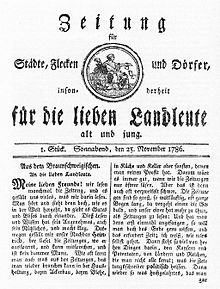Hermann Bräss
Hermann Werner Dietrich Bräss (also Bräß and Braess ) (born June 12, 1738 in Braunschweig , † November 1, 1797 in Dettum ) was a German Protestant pastor and newspaper editor.
Life
Little is known about Bräss' early years. He was born as the son of a button maker in Braunschweig (the house in which he was born at Kannengießerstraße 17 was destroyed in the Second World War). He attended the Brunswick Katharineum and studied in Helmstedt theology . Afterwards he was tutor in France from 1768 on . After his return in 1773 he became pastor of the parishes of Dettum and Mönchevahlberg east of Wolfenbüttel . He married Auguste Catharina Steinbrück, with whom he had three daughters and four sons. Presumably he died of vomiting ( cholera ).
Services

In 1786 Bräss founded the “newspaper for cities, towns and villages, especially for dear country folk old and young”. The first edition appeared in the Wolfenbüttel print shop Bindseil on November 25, 1786. It was also known as the “ Rothe Zeitung ” because of the title printed in red and appeared with two issues a week for twelve years; the edition was at times a good 1000 copies. Today's Wolfenbütteler Zeitung (a local edition of the Braunschweiger Zeitung) can be traced back to Bräss' establishment.
Bräss' work was recognized not only by contemporaries; It is praised for its content and style by several contemporary press historians and philologists, such as Martin Welke, Holger Böning and Peter von Polenz. They emphasize that Bräss, the publisher and editor in one person, successfully endeavored to deal with topics that were close to the reader and practical, with a clear layout, understandable style and solid information. As one of the first newspaper makers, he asked for letters to the editor and published them frequently. In order to encourage his audience to write unfamiliar, Bräss probably wrote the first letters himself. He himself remained anonymous as editor and author; only after his death were its functions officially known.
An edition of the newspaper for cities, spots and villages, called Rothe Zeitung, was published as a microfiche by Olms-Verlag, Hildesheim and New York in 1993.
literature
- Fritz Barnstorf: Pastor Hermann Braess, the Dettumer Bote and Brunswick household friend with his “Rothen Zeitung for the dear country people”. In: Braunschweigische Heimat. 52nd year 1966, pp. 128-134.
- Martin Welke: A pioneering journalistic achievement. In: 200 years of Wolfenbütteler Zeitung. Special edition of November 25, 1986, pp. II – V.
- Peter von Polenz: German language history from the late Middle Ages to the present. Volume 2: 17th and 18th centuries. De Gruyter, Berlin 1994.
- Holger Böning : The “newspaper for cities, towns and villages, especially for dear country folk, old and young” - a first successful “people's newspaper” of the 18th century. In: Peter Albrecht and Holger Böning (eds.): Historical press and their readers. Edition lumière, Bremen 2005, pp. 227–264.
- Andrea Mlitz: Dialogue-oriented journalism. Letters to the editor in the German daily press. UVK Verlagsgesellschaft, Konstanz 2008.
- Eckart Roloff : Hermann Bräß - A country pastor creates the letter to the editor. In: Eckart Roloff: Divine flashes of inspiration. Pastors and priests as inventors and discoverers. Wiley-VCH, Weinheim 2010, pp. 183-196, ISBN 978-3-527-32578-8 . 2nd updated edition 2012 (paperback), pp. 183–196, ISBN 978-3-527-32864-2 .
- Eckart Roloff: Robbespjahr and Hiäne. Hermann Braess on his 275th [birthday] . In: new Germany. Edition of June 12, 2013, p. 14.
| personal data | |
|---|---|
| SURNAME | Bräss, Hermann |
| ALTERNATIVE NAMES | Bräss, Hermann Werner Dietrich; Bräß, Hermann Werner Dietrich; Braess, Hermann Werner Dietrich |
| BRIEF DESCRIPTION | German Protestant pastor and newspaper editor |
| DATE OF BIRTH | June 12, 1738 |
| PLACE OF BIRTH | Braunschweig |
| DATE OF DEATH | November 1, 1797 |
| Place of death | Dettum |